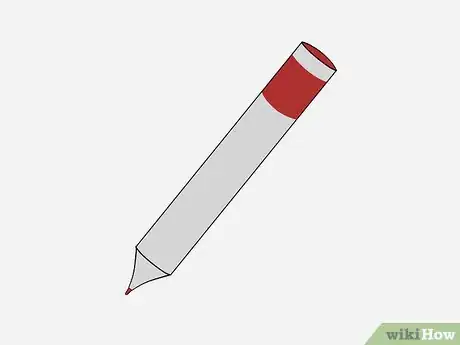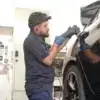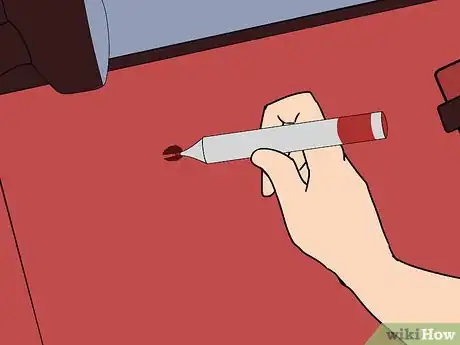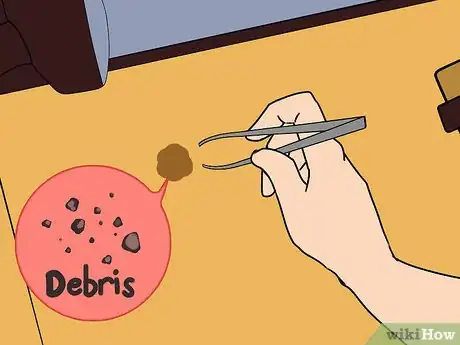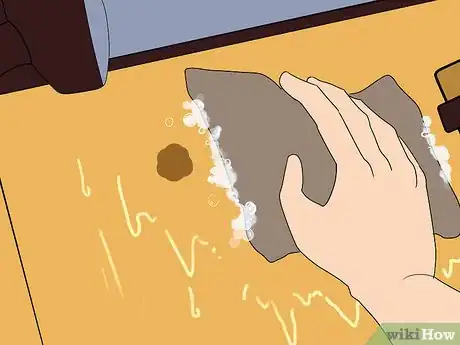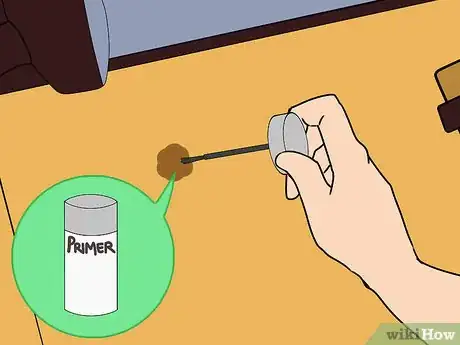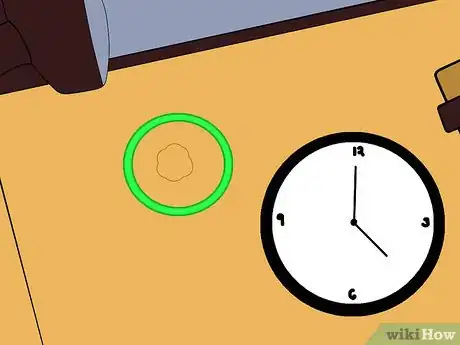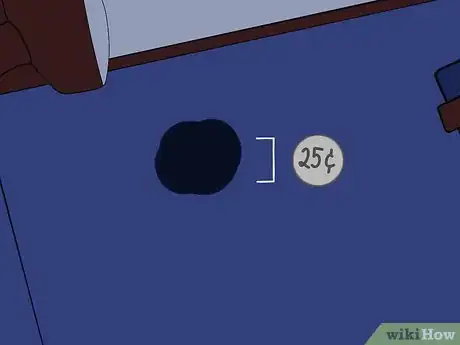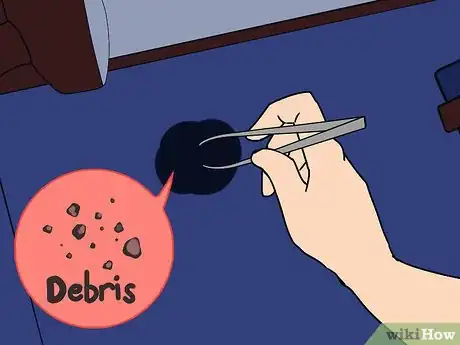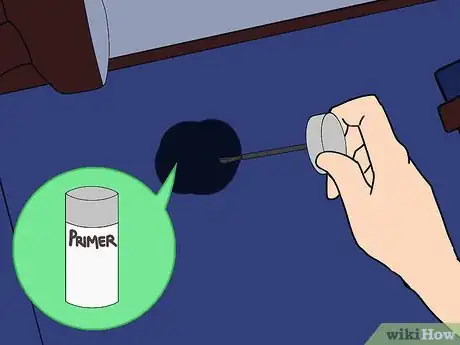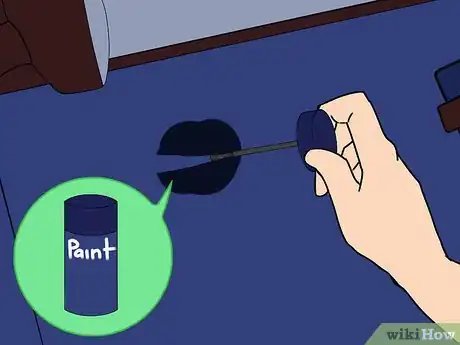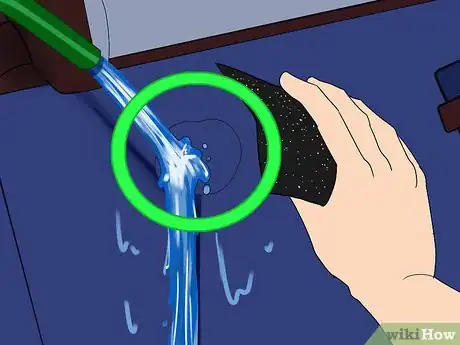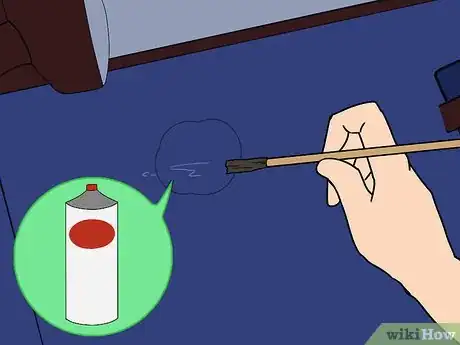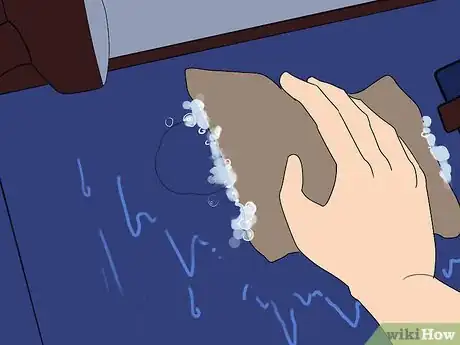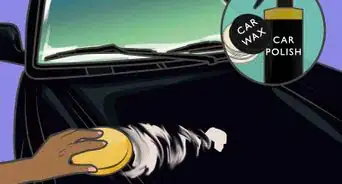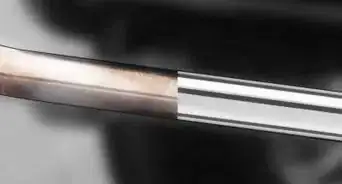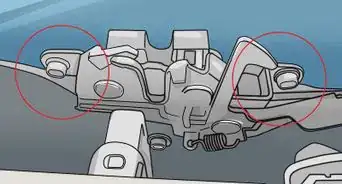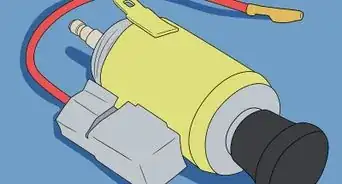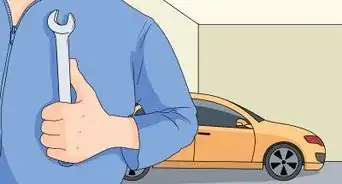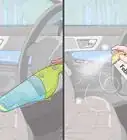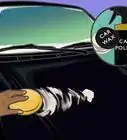This article was co-authored by Angel Ricardo. Angel Ricardo is the owner of Ricardo's Mobile Auto Detail headquartered in Venice, California. With over 10 years of experience in mobile detailing, Angel continues to attend auto detailing trainings to improve his customer service and auto detailing skills.
There are 9 references cited in this article, which can be found at the bottom of the page.
This article has been viewed 285,080 times.
Chipped paint on your car can be more than an eyesore. Exposed metal can lead to rust, which can spread beneath the paint and ruin entire pieces of the body of your car. Even a small chip in your paint caused by a tiny pebble can lead to big headaches if you don’t repair it properly. Fortunately, most chips can be repaired at home with minimal tools and experience. You may not be able to return the car to a showroom finish, but you can prevent rust from developing and even repair the chip well enough that most people may never notice.
Steps
Touching Up Small Chips
-
1Determine the severity of the chip. Chips in the paint of your car can be classified into one of three categories: small, medium, and large. Small chips tend to be smaller than a dime and require less work to address. Medium chips are larger than a dime, but smaller than a quarter and large chips include chips in your paint that are as large or even larger than a quarter. Other things that can make a chip more difficult to repair include rust and flaking paint.[1]
- Small chips should be free of rust and smaller than a dime.
- Flaking paint requires the removal of the loose paint, which will make it larger than a “small chip” for repair purposes.
-
2Purchase a touch-up paint pen. Unlike scratches, which can often be buffed or wet sanded out, a chip in your paint will require that you apply new paint to the metal. The paint on your car does more than simply make it look good, it also protects the metal beneath it from the elements. If the metal is exposed to air and moisture for too long, it will begin to oxidize and rust. Using touch up paint can help you prevent rust and with the wide variety of options available, it should be easy to find one that matches your car exactly.[2] Touch up pens are designed specifically for small chips and can be very easy to use.[3]
- Check on the sticker inside the door of all vehicles made after 1983 for a paint code. If the code for paint is not clearly labeled, take a picture of the sticker to show the clerk at your local auto parts store so they can find the code.
- Some stores may ask for the Vehicle Identification Number (or VIN) for your vehicle to ensure they can find an exact match for your paint. Your VIN can also be found on the sticker inside your door.
Advertisement -
3Clean the area around the chip. Before you can do any painting, it’s important that you wash the area thoroughly. Painting over things like dirt can ruin the appearance of the final product and it may fall off, revealing the chip once again. Rinse the area of the car, then wash it with warm soap and water before rinsing it again and then dry it well.[4]
- Make sure the car is completely dry before applying any paint.
-
4Use the paint pen to fill the chip. Once the car is completely dry, remove the cap of the paint pen and place the point of the pen in the center of the chip. Depending on the type of paint pen you are using, you may need to press the pen down slightly to release the paint. You may not need to move the pen to fill a small chip, as the paint will be released and should fill the space needed, but move the pen from side to side a bit if you need to release more. Use enough paint to over-fill the chip slightly, as the paint will shrink a little as it dries.[5]
- Do not apply enough paint to allow it to drip. The paint color will match, but things like drips will stand out.
- If you accidentally apply too much paint, wipe off the excess immediately and thoroughly.
-
5Allow the paint to dry then wash and wax the car. Make sure the paint dries completely before washing the car, as you can easily scrape or damage the new paint while it is still tacky. Depending on the type of paint pen and how much paint you used, it may take only an hour or so to dry completely, but may require as much as a full day. Once the paint is completely dry, wash the entire car and then apply a fresh coat of wax.[6]
- Touch the paint lightly to determine if it is dry. If it feels sticky at all, it isn’t dry yet.
- Applying a new coat of wax will help make the car’s paint appear uniform in color. It will also help protect the paint.[7]
Repainting Medium-Sized Chips
-
1Remove any debris. Medium-sized chips tend to be between the size of a dime and a quarter. Because of their increased size, it isn’t uncommon for small amounts of debris to get stuck in the chip or to the paint on the borders of the chip. Remove small debris with your fingers or a pair of tweezers before washing the area of the vehicle. If you attempt to wash it first, the sponge could catch small bits of debris and drag it through the rest of the good paint, causing small scratches.[8]
- Using tweezers can help you to get small bits of debris that may be caught in the paint before you move on to washing the vehicle.
- Sometimes blowing on the area or using canned air can free up and dispel small bits of debris.
- Ensure none of the paint is flaking off as you remove the debris. Flaking paint may lead to a large chip.
-
2Wash the area around the chip. Once the chip and surrounding area are free from debris, wash that part of your car just as you would for a small chip. First rinse the area, then apply warm soapy water with a sponge before rinsing it again. Ensure the car is completely dry before applying any paint.[9]
- Washing the area also ensures there is no debris or sediment that may get trapped by the new layers of paint.
-
3Use rubbing alcohol to remove grease and oil. Once the area around the chip is clean and dry, put some rubbing alcohol, Prepsol or enamel reducer on a rag and use that to clean the chipped area once again. This will remove any grease or oils in the area that may make it difficult for the primer to establish a strong bond to the metal. You likely won’t be able to see any oil or grease, but it does not need to be visible to compromise the painting process.[10]
- Simply rub the rag on the chip itself and around the edges of it.
- Remember that this will remove wax and even clear coat from the remaining paint, so avoid scrubbing the painted area. Instead simply rub the chip lightly.
-
4Apply primer to the metal. Automotive primer can be purchased at your local auto parts store as well as at many large retailers like Walmart or Target. The primer will come in a small bottle with a brush, unlike the paint pen used for smaller chips. Use the applicator brush to apply the primer to the dry, clean metal, taking care to get very little of it on the paint surrounding it. Use only enough primer to cover the unpainted area with a thin, but solid coat.[11]
- While you will be painting over the primer, applying it to the paint around the chip will raise the height of the paint in that area, creating a blemish in the paint you will be able to see.
- Ensure you don’t use more primer than is necessary. Immediately wipe off and thoroughly clean any drips.
- Make sure the primer dries completely before moving on to the next step. If it feels sticky, it isn’t dry yet.
-
5Apply touch up paint by dabbing the applicator brush. Medium and large-sized chips require touch up paint that has an applicator brush instead of the pen. While the paint is the same, the method used to apply it is slightly different. For medium-sized chips on the smaller side, a paint pen may still do the trick. Shake the touch up paint thoroughly, then dip just the tip of the applicator brush into it. Dab the applicator brush in the center of the chip and move it around slightly, allowing the paint to stick to the metal and expand. Dip the brush in again, then touch it to the paint in the same area, allowing the paint to flow off of the applicator brush and settle on the vehicle, instead of stroking it on as you might when painting a house.[12]
- It may take a number of dabs to fill the chip, but doing it in this manner allows the paint to settle evenly.
- Fight the urge to apply more paint to expedite the process. Adding too much paint at a time can result in dripping or bubbling.
-
6Allow the paint to dry and re-apply if necessary. Once the touch up paint has dried, evaluate the result. If the paint has sufficiently filled the chip and the sides of the touch up paint have become flush with the surrounding paint, you are ready to move on to the next step. If the touch up paint settles slightly lower than the surrounding paint or some metal is still visible, apply another coat of paint by dabbing it on the chip just as you did previously.[13]
- The paint may look raised above the surrounding dry paint as you dab it. It will shrink as it dries, allowing it to flatten out.
- Patience during this process will ensure you end up with the best possible final product.
- Ensure the touch up paint is completely dry before moving on to the next step (it may take a number of hours).
-
7Wash and wax the vehicle. Although you only painted one small portion of the vehicle, it’s important to wax the entire vehicle at the same time to ensure the glossiness of the paint matches throughout. Wax protects your paint from the elements and from sun-caused fading, so failing to apply new wax to the entire car could result in the paint fading into slightly different shades. You will need to apply wax to the newly painted area in order to protect the new paint as well as to make the glossiness of it match the rest of the car.[14]
- Make sure to wash and wax your entire car to protect the paint and ensure the levels of glossiness match.
Preparing to Fix Large Paint Chips
-
1Assess the damage. A large paint chip is usually the size of a quarter or even larger. Large chips can be the most difficult to repair because the area that you will need to repaint will be more visible. If the chip reaches a few inches in diameter or continues to flake into a larger and larger chip, you will probably need a body shop to repaint the entire body component.[15] Make sure the paint damage is something you can handle with touch up paint before beginning.[16]
- Touch up paint should only be used on chips in your paint that are smaller than a few inches in diameter.
- Do not attempt to apply paint over existing paint that is chipping, as it will flake off and ruin the repair.
-
2Use tweezers or a dental pick to remove debris and chips. Larger chips are more apt to accumulate debris that you must remove before moving on to the next step. Use your fingers or tweezers to remove any large debris and try blowing on the area or using canned air to remove any sediment. Large chips may result in the surrounding paint flaking. Make sure to remove the paint that flakes, as it is no longer bonded to the metal and will eventually come off anyway – taking your new touch up paint with it. You can use your fingernails, tweezers or a dental pick to remove flakes.[17]
- Be careful not to remove any good paint from the area surrounding the chip when removing flakes.
- Make sure you don’t scratch the good paint with any tools you are using to remove flakes or debris.
-
3Remove any surface rust. Because large chips expose more metal to moisture, there is an increased risk of rust. Remove rust by applying some CLR to a Q-tip and swabbing the metal. If the rust has penetrated deep enough to create a hole through the door or your Q-Tip penetrates the metal, it means the rust has ruined the body component and cannot be repaired by simply painting over it. A body shop can determine if rust of that magnitude can be removed and repaired or if you will need to replace that component of the body of the car. If there is no deep penetration of rust, simply apply the CLR with different Q-tips until they start coming up clean.[18]
- Once the Q-tips start coming up clean, wipe the area you applied the CLR to with rubbing alcohol to remove the chemical and any grease or oil that may remain.
- Failing to completely remove the rust will result in the new paint you apply flaking off with bits of rust.
- Stopping the progress of rust can prevent you from having to pay for expensive repairs to the body of your car in the future.
-
4Sand the edges of the chip. Use fine-grit sandpaper (2000 grit should suffice without causing further scratches) to round off the edges of the paint around the chip to reduce the visibility of the repair. Hard defined paint edges surrounding a large chip can make the repair obvious to the naked eye, but by rounding off the edges you can help the new paint blend with the old more effectively. Do not wet the sandpaper as you might when wet-sanding automotive paint, as this can cause rust to begin to form on the bare metal. Instead, use dry sandpaper and replace it often as the paper becomes clogged with paint.[19]
- Gluing pieces of sandpaper to small craft sticks or dowels can help you to control the angle in which you sand, but it is not necessary to complete this step.
- Sand the edges of the chip until they are rounded off and less distinct to the naked eye.
- Wash the area after sanding it to remove any new sediment.
Repainting Large Chips
-
1Apply the primer. Once the chip is sanded, clean, and dry you can apply the primer just like you would on a medium-sized chip. Apply a thin layer of primer to any bare metal using the applicator brush. Be careful not to apply so much primer that drips begin to form, as they could reach the paint or cause the final repair to look uneven.[20]
- Allow the primer to dry completely before moving on to the next stage.
- It may take several hours for the primer to dry to full “cure.” Read the label on the automotive primer you purchased to know for sure.
-
2Wet sand the primer. Once the primer is dry, it may appear to be textured due to the bristles of the brush or the way it settled on the metal. Use 2000 grit sandpaper and a hose to wet sand the primer. Turn the house on and hold it above the chip so the water is pouring directly onto the dry primer, then use the sandpaper to lightly sand only the primer. Be careful not to sand the clear coat or paint from the surrounding area as you lightly sand the primer until it is completely flat.[21]
- Wet sanding the primer will help ensure it takes on a completely flat and even finish.
- Allow the sanded primer to dry again completely before moving on to the next step.
-
3Apply the touch up paint to the primer. Using the same method as you might for a medium-sized chip, apply the touch up paint to the primer. Dab the applicator brush in the paint, then touch it to the center of the chip and allow the paint to settle evenly. Repeat this process until the paint covers the entire primed area. You may need to apply multiple coats, or one coat could suffice depending on the touch up paint you purchase.[22]
- Allow the paint to dry completely before determining if you should apply another coat.
- If you attempt to apply the paint before the primer has dried from the wet sanding, grey swirls could appear in the paint.
-
4Wet sand the newly dried paint. Once the paint is completely dry, repeat the wet sanding process on the fresh paint to remove any texture and make it completely flat. Make sure to use different extremely fine sandpaper (2000 grit or more) and keep the water flowing over the paint as you sand it to prevent doing damage to the newly repaired area. Dry sanding will result in scratches in the paint.[23]
- If you make a mistake or identify an issue with the paint during the wet sanding, allow it to dry completely and then apply more touch up paint.
- Sand the area lightly until it is completely flat and even with the surrounding area.
-
5Apply clear coat. Some touch up paint will come with a small container of clear coat, but you may need to purchase it separately. Clear coat is lacquer based and should be applied in a thin coat over the fresh paint using the supplied brush applicator. A small, fine bristled paintbrush will also suffice. Apply the clear coat to the new paint; this will both protect the paint and provide a healthy shine that you will further blend with the surrounding paint with wax in the following step.[24]
- Apply the clear coat by painting a thin layer of it to the new paint.
- The freshly painted chip may still be slightly visible to you as you complete the clear coat, but remember that it will be difficult to see if you aren’t too close.
- Allow the clear coat to dry completely before moving on.
-
6Wash and wax the entire car. Once the repaired area is completely dry, wash and wax the entire car to ensure the wax is evenly distributed. Waxing the car will further blend the freshly painted area with the surrounding paint and make the repair even less noticeable. You may want to wait a few days before waxing to ensure the repaired layers of clear coat, paint, and primer are all completely dry so you don’t run any risk of damaging the new paint in the process.[25]
- You may want to repair any other chips you intend to fix before waxing the vehicle.
Expert Q&A
Did you know you can get expert answers for this article?
Unlock expert answers by supporting wikiHow
-
QuestionWhat should I do if there's a big chip in the paint?
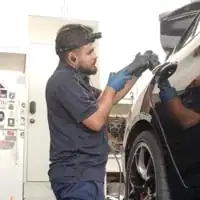 Angel RicardoAngel Ricardo is the owner of Ricardo's Mobile Auto Detail headquartered in Venice, California. With over 10 years of experience in mobile detailing, Angel continues to attend auto detailing trainings to improve his customer service and auto detailing skills.
Angel RicardoAngel Ricardo is the owner of Ricardo's Mobile Auto Detail headquartered in Venice, California. With over 10 years of experience in mobile detailing, Angel continues to attend auto detailing trainings to improve his customer service and auto detailing skills.
Auto Technician
-
QuestionIt will be 1 - 2 weeks before the touch-up paint arrives (new car). Can I put something over the chip to seal it from the air and water until the paint comes in?
 Community AnswerTechnically, yes, but it will either force you to sand, which defeats the purpose of touching up, or look really bad (for example, sticking a pea of wacky tacky on it). If it's small enough for a simple touch-up with no sanding, it probably won't get worse if you just leave it as-is.
Community AnswerTechnically, yes, but it will either force you to sand, which defeats the purpose of touching up, or look really bad (for example, sticking a pea of wacky tacky on it). If it's small enough for a simple touch-up with no sanding, it probably won't get worse if you just leave it as-is.
References
- ↑ http://www.popularmechanics.com/cars/how-to/a6092/how-to-repair-chipped-car-paint
- ↑ Angel Ricardo. Auto Technician. Expert Interview. 1 October 2019.
- ↑ http://www.popularmechanics.com/cars/how-to/a6092/how-to-repair-chipped-car-paint/
- ↑ http://www.popularmechanics.com/cars/how-to/a6092/how-to-repair-chipped-car-paint/
- ↑ http://www.popularmechanics.com/cars/how-to/a6092/how-to-repair-chipped-car-paint/
- ↑ http://www.popularmechanics.com/cars/how-to/a6092/how-to-repair-chipped-car-paint/
- ↑ Angel Ricardo. Auto Technician. Expert Interview. 1 October 2019.
- ↑ http://www.popularmechanics.com/cars/how-to/a6092/how-to-repair-chipped-car-paint/
- ↑ http://www.popularmechanics.com/cars/how-to/a6092/how-to-repair-chipped-car-paint/
- ↑ http://www.autoeducation.com/carcare/paintchips.htm
- ↑ http://www.popularmechanics.com/cars/how-to/a6092/how-to-repair-chipped-car-paint/
- ↑ http://www.autoeducation.com/carcare/paintchips.htm
- ↑ http://www.autoeducation.com/carcare/paintchips.htm
- ↑ http://www.autoeducation.com/carcare/paintchips.htm
- ↑ Angel Ricardo. Auto Technician. Expert Interview. 1 October 2019.
- ↑ http://www.familyhandyman.com/automotive/diy-car-paint/how-to-repair-chipped-car-paint/view-all
- ↑ http://www.popularmechanics.com/cars/how-to/a6092/how-to-repair-chipped-car-paint/
- ↑ http://www.popularmechanics.com/cars/how-to/a6092/how-to-repair-chipped-car-paint/
- ↑ http://www.autoeducation.com/carcare/paintchips.htm
- ↑ http://www.popularmechanics.com/cars/how-to/a6092/how-to-repair-chipped-car-paint/
- ↑ http://www.autoeducation.com/carcare/paintchips.htm
- ↑ http://www.autoeducation.com/carcare/paintchips.htm
- ↑ http://www.autoeducation.com/carcare/paintchips.htm
- ↑ http://www.popularmechanics.com/cars/how-to/a6092/how-to-repair-chipped-car-paint/
- ↑ http://www.autoeducation.com/carcare/paintchips.htm
About This Article
To repair small paint chips on your car, start by cleaning the area with soap and warm water, and letting it dry completely. Then, use a touch up paint pen to fill in the chip, let it dry, then wash and wax your car. For medium sized chips that are between the size of a dime and a quarter, wash and dry the area, then wipe it with rubbing alcohol to remove the oil and grease. Next, brush on a layer of automotive primer, let it dry, then paint over it with a touch up paint that comes with a brush. To learn how to fix large paint chips on your car, scroll down!

